The information in this page falls under a few categories depending on who you are, but the first way to get started in RDA/Para vaulting is to contact an RDA Group or a BEV Group. However, there is quite patchy provision of vaulting across the country, whether you have a disability or not, so you may find the information below useful too.
The goal here is to give an overview of how most people get started in the sport. Obviously there is a huge amount more that can be said about training and competing in the longer term, which isn't in the scope of this particular page.
The information below is under three main headings - scroll down to find your bit!
- For potential vaulters and their parents/carers
- For RDA Groups
- For BEV Coaches
For potential vaulters and their parents/carers
Vaulting is not a sport you should expect any horse to be able to do automatically. It takes time, knowledge and expertise to train a vaulting horse in a way that is safe for future vaulters and for the horse themselves. If you have a horse already and you would like to train your horse for vaulting, please make contact with somebody who knows what they are doing for their support and advice. It is a very specialist activity and knowing a lot about horses in other disciplines is not enough to make it safe and fair on the horse.
Most people, of course, do not have their own horse to begin with anyway. If you are able to find a vaulting group near you that has space, then that's great - get along and get started! If not, why not find people near you who could potentially get something going? Maybe an RDA Group could register and train its coaches? Maybe a riding school owner could look into opening a BEV Group? If you don't ask, you'll never know! Also, consider having some taster sessions at a group even if it's too far away for you to visit regularly. It's a great way to give it a go, and you may find that your enthusiasm is infectious enough to inspire people near you to get something up and running.
If you are fortunate enough to find a group that you can join, here are a few things to know for when you first start:
- Check below to see what you should wear. Avoid baggy clothes including hoodies (even though most of us are guilty of having vaulted in them!)
- Don't worry about buying any specialist kit until you're sure you want to carry on.
- Don't wear any jewellery, including watches. It can be unsafe and you'll never find an earring if it pings off in an arena!
- If you have to wear items such as hearing aids, or if you have any permanent tubes or bags attached, speak to the coach beforehand about keeping these safe. It doesn't necessarily mean you can't vault; it just means that some things will have to be approached a little differently.
- Let the coach know of any health issues you have, whether or not you think they'll affect you on the horse. Not doing this means you won't be safe, and isn't fair on the coach or the horse.
- Relax and ENJOY YOURSELF! Vaulting is really good fun. Don't expect to be amazing at everything straight away - expect to be challenged. Just relax and, literally, enjoy the ride!
What am I likely to do in my first session?
- You'll do a warm-up away from the horse to get you moving and to get your heart and lungs working hard! Like everything else, this will be tailored to your needs, appropriate to your disability. Once you've got moving, you'll also do some stretches.
- You'll be taught the basics on the barrel: how to mount, some first moves to try, and how to dismount.
- You'll be shown how to approach the vaulting horse and will learn to move towards and away from him while he's moving.
- You'll have a go on the horse - time to put everything you learned on the barrel into action!
- You won't be on the horse for long - in vaulting, everyone goes on for a short period of time and, although we share a horse, we usually get to go on more than once.
- At the end you should do a cool down, including some stretches.
- You may also be expected to help look after the horse, e.g. by carrying his tack to the tack room, cleaning the tack, putting the horse to bed, etc.
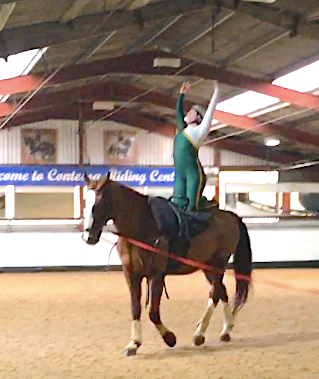 |
| The free kneel is one of the first moves you will learn |
- Leggings
- A closely-fitting top (but you need to be able to move and breathe!)
- Trainers when you first arrive. If you have boots, bring them in case you need them to go into the stable.
- Shoes with as thin a sole as possible - or ask to borrow some vaulting shoes
- A helmet - compulsory in RDA vaulting and in all BEV sessions before you have BEV membership (optional after that). Ideally, the helmet shouldn't have a peak. It will need to be up-to-date in terms of safety standards. If you don't have a helmet, you should be able to borrow one.
What if it's too difficult or scary?
- Vaulting is not an easy sport and it is sometimes scary - but most vaulters find that this is what they love about their sport. It's OK to find things difficult and scary!
- You should always be able to talk to your coach or a volunteer to say if you need help. If it's easier, you could ask a parent or carer to be there too.
- Lots of things are scary the first time you try it, then seem much easier afterwards. Sometimes we just have to take a deep breath, breathe all the way out again, and give it a go. You might surprise yourself!
- Remember that there is no time pressure to learn or achieve anything - you move at your pace. Vaulting isn't school or work; you don't have to do it at all and you are in control of everything you want to do.
- It's important for vaulters to know that they don't have to make anyone else happy - their coach, parent, carer, sibling, friend, pet newt, etc. In fact, most of the time those people will be at their happiest when YOU are at your happiest! You should never feel under pressure from anyone else to try anything new or daunting. If you don't want to do something, it is ALWAYS OK to say no. (Something I always try to remember is that most people wouldn't have the guts to get on the horse in the first place. Even if we feel frustrated with ourselves, we have to remember what it took to get us there and how much we've already overcome. It doesn't matter how much or how little you do - you are already amazing!)
If I like it, how do I get involved in competing?
- Most BEV and RDA Vaulting groups are only to keen to get their members out competing, if that is what the vaulter in question wishes to do.
- First of all, tell someone you'd like to compete, or ask what you would need to do to be considered for that. Sometimes people don't put you forwards simply because they don't know you want to do it!
- Ask for feedback when you vault - how could you improve your score on a bench? Would this be good to have in a freestyle? Would this music work for a freestyle routine?
- If possible, watch videos online of vaulters competing. They can be at any level - complete beginners all the way up to World Champions. How does the competition work? What do they do, or not do? What works well for them?
- Work hard!
For RDA Groups
Vaulting is a specialist activity within RDA and, although in theory any Group can apply to offer vaulting to its participants, there is a fair bit of specialist training and preparation that the Group will need to do first.
For accurate and up-to-date advice on this, please visit the RDA website and make contact with the appropriate Vaulting Rep at RDA UK. It would also be a good idea to be in touch with an existing BEV or RDA Vaulting Group to learn more about the sport and how it can help disabled people. Remember that you will need the support of your Trustees to include vaulting in your activities.
Some ideas to persuade your Trustees (and anyone else!) that vaulting might be good for your RDA Group:
- for each participant, it is cheaper than riding as vaulters share a horse
- vaulting is also cheaper for a Group to run (especially if you focus on the barrel!)
- although volunteers will be critical in making it all work, you may need fewer for vaulting than for riding
- vaulting can be a great way to make use of a mechanical horse, if you have one available (although vaulting-wise it's not the most useful acquisition if you don't already have one)
- vaulters can compete at the National Championships, even on the barrel horse, without needing to qualify, which could bring a lot of exposure and success for your Group
- vaulting tends to attract younger volunteers - something the RDA as a whole desperately needs!
- you will have a ready-made display team for fundraising events
- vaulting uses lots of different skills both in participants and volunteers - maybe you have someone who can edit music perfectly, or create costumes?
- vaulting is a great way to teach participants about caring for a horse, because consideration of the horse is built into judging at all levels
- vaulting generates a great team spirit amongst participants in a way that riding can't always manage
- vaulting is amazing exercise for participants (and volunteers!) and has many therapeutic benefits
A good place to start would be with acquiring a barrel horse. These are not compulsory for new BEV Groups but they are fundamental to training at all stages of a vaulter's development, and they are critical in protecting your horse. The majority of training in vaulting occurs away from the horse. Horse time is very precious, because there is only so much vaulting a horse can be expected to do, particularly when working above the walk. Having a barrel means that a lot of training can take place there instead of on the horse's back, and it means that mistakes can be ironed out early on on an inanimate object rather than subjecting the horse to the discomfort of inexpert vaulting.
Barrels come in a variety of sizes and configurations. You can opt for one that has handles welded on or a plain barrel upon which you can put a roller. The second option can feel more 'real' but tends to be more expensive (the roller has to be bought separately) and there is the potential for the roller to slip, which whilst realistic may not be great for people first learning a move.
Ensure that your barrel is high enough that people get a feeling for the height, but not so high that mounting and dismounting become difficult or dangerous. If you have welded-on handles it is a good idea to cover them to make them a little softer and a more bearable temperature in the extremes of winter and summer - I use sticky tennis racket grip on mine. For this style of barrel you will also need something to mimic the Cossack stirrups on a vaulting roller - some spare stirrup leathers do the job and, being flat, are comfier for the vaulters than rope or string.
 |
| A barrel covered in carpet with stirrup leathers and taped handles |
You can start training and competing in RDA Vaulting simply with a barrel, but many Groups will want to train a horse as well. If you are very lucky you may be able to buy or loan a ready-trained horse, but if not the average RDA riding horse would make a decent RDA Vaulting horse. Please visit the page on horse training for advice on this.
Personnel-wise, RDA will need a Coach and a Lunger, although it is perfectly possible to double up provided the Coach is comfortable doing both at the same time. A separate Lungeing certificate can be attained by anyone wanting to take part in this way without doing all the Coach training as well.
RDA Vaulting Groups will also need a small army of volunteers. Depending on the ages of the vaulters and the natures of their disabilities, it may be appropriate to have a ratio of one volunteer to each vaulter (this is still fewer volunteers than needed for a rider who is led with two sidewalkers). A lot of the session will be spent with the vaulters on the ground, sometimes with the horse in the arena too, so volunteers need to be alert to any dangers and ensure that their charges are kept safe. Volunteers should be offered some specialist training to understand the ways in which the horse and vaulters move during a session, as well as some coaching points for warming up and basic moves.
In terms of equipment, an RDA Group should have the following on their list:
- A barrel, with a barrel roller or sticky tennis grip and stirrup leathers
- Mats to put around the barrel and on the floor during warm ups
- A small trampette, springboard or air track device to assist with mounting the barrel
- A fit, suitably trained horse
- A vaulting roller with girth
- Lunge line and side reins
- Lunge whip
- Boots if required for the horse (brushing/over reach)
- A back pad and sausage pad
- A saddle, because your horse will need to be ridden too
- A mirror
- Gym equipment, e.g. an exercise ball, push-up handles, ankle weights etc.
- An assortment of shoes and up-to-date hats
- Some sort of facility for videoing vaulters and allowing them to watch themselves back
- A sound system that allows you to play music
Items 1-3 are necessary for all groups.
Items 4-10 are necessary for all groups training on the horse.
Items 11-15 are desirable for all groups. 14 and 15 don't have to be fancy - a phone and a laptop will do for video analysis, and a phone and bluetooth speaker can do the music if you don't have anything better rigged up!
For BEV Coaches
There is no reason why any BEV coach should be unable to coach a para vaulter. As with anything else, some will have more experience, some will be more adept at it, and some will enjoy it more than others, but fundamentally a BEV coach should be able to take on a disabled vaulter as readily as they would any other. Disabled vaulters are judged in the same way as their non-disabled peers, and will encounter many of the same challenges as them too. A few key skills are required to be a good para coach:
- initiative
- patience
- imagination and creativity to get around problems
- good communication
- the ability to listen - really listen!
- an encouraging and positive demeanour
- a genuine will to help the vaulter as an individual
- an absence of bias and prejudice and an openness to allow people to have a go and prove themselves
You may notice that many of these are required to coach anyone!
In other words, if you are a good vaulting coach already, you can be a good para coach.
That said, it can be daunting to take on disabled people in your sporting sessions. Here are some tips from my own experience, and from having spoken to coaches who have taken me on and had to handle my disabilities too.
It is absolutely OK to ask them about their disability if they wish to take part in your session. Some people don't like talking about their disability, so see if they'd be happier to give you information in writing. If they are not prepared to give you any information, it is reasonable for you to say that you are not happy for them to join in. You need to protect them, everyone else and yourself, and you cannot do this if you are not adequately informed. Be strict about this from the outset, and don't feel bad about saying 'no' if they will not help you. You could be putting them and others in danger if you let them take part without knowing their story.
That said, do respect their privacy when they talk to you about their disability. The information is given to you in order that everyone is kept safe, and it is not for you to broadcast. However, you do need to ensure that the vaulter and/or their parents/carers are aware that information will need to be shared with other coaches and volunteers where it is necessary.
Even if you aren't an RDA Group, the RDA New Participant Form is helpful in giving some areas you may wish to ask about, e.g. attention/concentration, communication difficulties, ability to follow instructions, etc. You also need to know if they have any medical devices, which could include hearing aids, cochlear implants, stents and shunts, metal plates and rods, tubes and bags, etc. Having these things doesn't necessarily mean that the individual cannot vault, but you might need to be a bit more cautious with certain moves. You may also wish them to have a note from a doctor or surgeon confirming that it is safe for them to vault.
For a list of contraindications (conditions with which it is NOT safe to vault) please check the RDA website.
Once you have learned a little of the vaulter's disability, observe them in the warm up. Look out for...
- core strength
- communicating with others
- co-ordination
- understanding instructions
- balance
- jumping and timing (for mounts)
- flexibility
- pain/discomfort
- general mobility
- moving on the barrel, especially the ability to move softly
- how happy they look to be there!
These are important things to consider before you get them on a horse:
- How will they mount and dismount?
- Which horse is appropriate for them?
- Are any basic moves unsuitable for this person?
- How will you communicate with them?
- Can they do leg changes? (Useful for moving around and dismounting)
- How long can they manage on the horse before getting too tired?
- Do they have the core strength to sit up straight?
- Do you need sidewalkers or someone else on the horse?
- How good is their grip strength (e.g. can they hold on if the horse is spooked or bucks?)
- Do they understand how to be considerate to the horse?
- Do you want parents/carers to watch or will they distract the vaulter or make them feel nervous?
Trust your instinct. If in doubt, allow a bit more time. Don't be afraid to try things in halt, or with lots of extra support. The vaulter needs to feel safe more than anything else - there will be plenty of time to push them later, provided they have the confidence to come back!
 |
| For more (less flippant) info please click here |


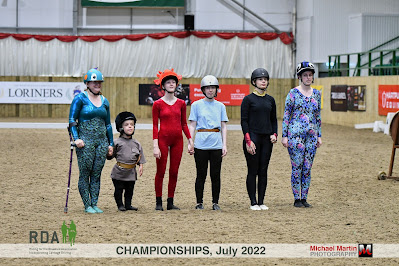
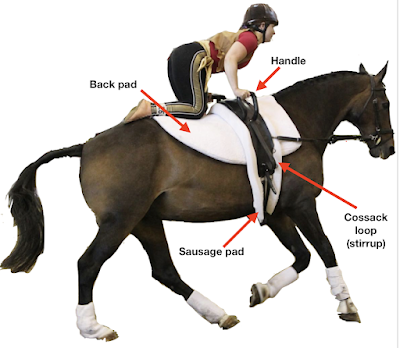
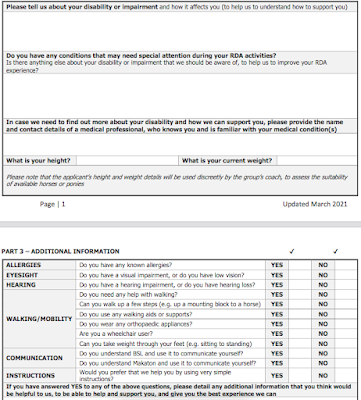
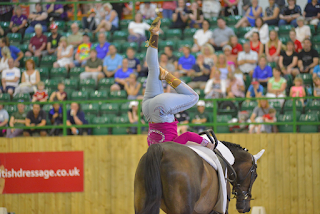

No comments:
Post a Comment